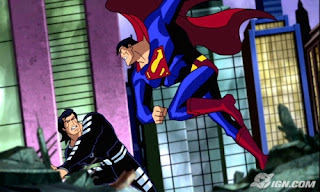Artwork by Dan Jurgens and Jesus Marino
One of my favorite parts of the 'New 52' relaunch was the potential to make Superman great again. After decades of learning to hone his powers, good ol' Supes was literally unstoppable. God complex stories are nice, but they too can get old after a while. Over in Action Comics, Grant Morrison's origin story has explained that, in his early days as a superhero, couldn't fly or lift more than a car. Also, toning down the boy scout routine was essential; trying to convey a character like Superman into the 21st century meant shedding the "Aww, gee golly shucks!" attitude that was popular when the character was first developed.
Last time, Clark defeated his daemonite doppelgänger after it went on a villain killing spree. This month, the cause of all Superman's worries in the last six issues comes to light. After a couple of run-ins with what looks like a minotaur robot, Supes is teleported to a fortress in the Himalayas where he comes face to face with Helspont, a long-time Wildstorm Comics super villain. One of the reasons for DC relaunching everything under the 'New 52' header was to bring in characters from the Wildstorm and Vertigo imprints that DC owns. Helspont and the dameonites represent this aesthetic. It's nice that the first arc of this new Superman series wasn't a Lex Luthor or Brainiac encounter. The encounter between Superman and Helspont is great. The daemonite warlord doesn't understand, as a Kryptonian far more powerful than anyone else on the planet, why Superman hasn't conquered Earth yet. It's fantastic writing because Helspont is 'technically' new to the planet, so he logically reached out to the most powerful being. The new creative team of Keith Griffin, Dan Jurgens and Jesus Marino is fantastic. The artwork is solid, with some jagged edges that convey Helspont's authoritative presence, and the writing is still as solid as George Perez's work on the first six issues. The end of the issue sets up next month's the main event: Superman Vs. Helspont.
GRADE:
B+

.jpg)



























